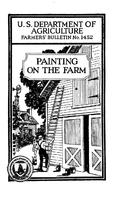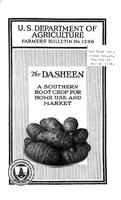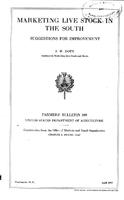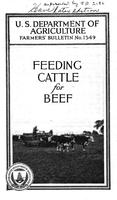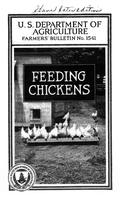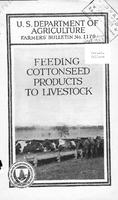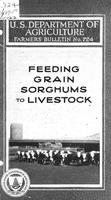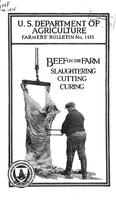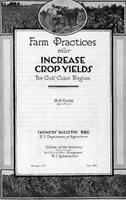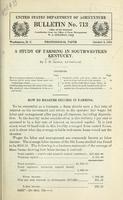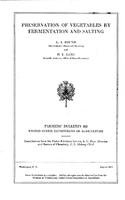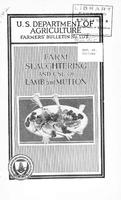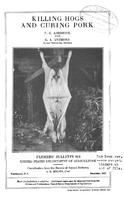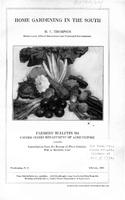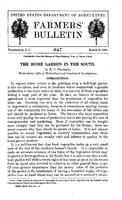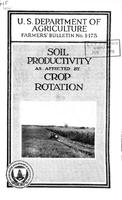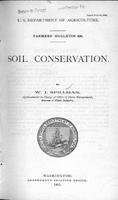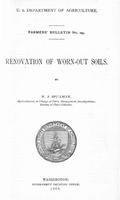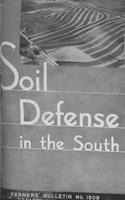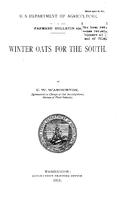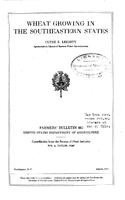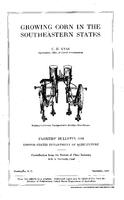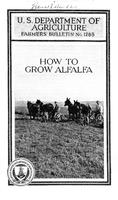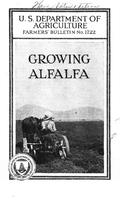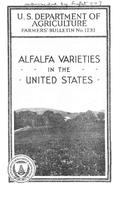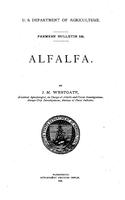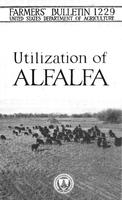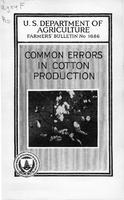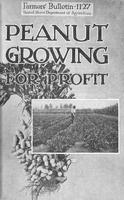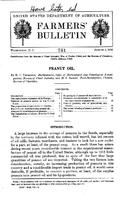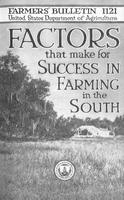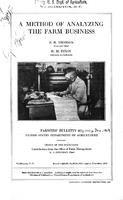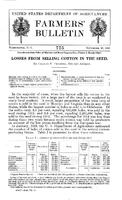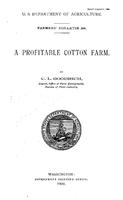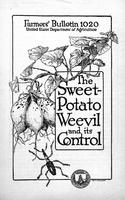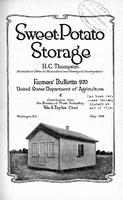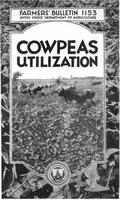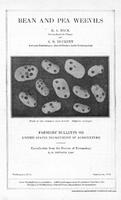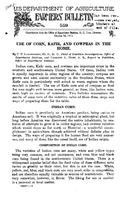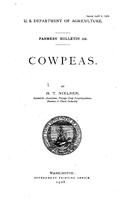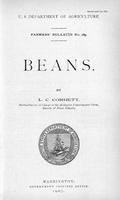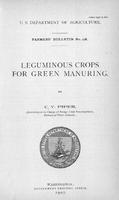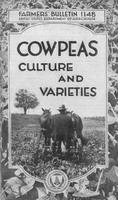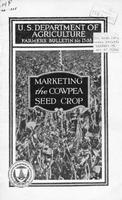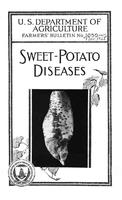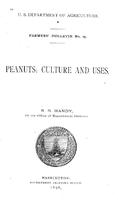Browse Items: 60
Page 1 of 1
Painting on the Farm
THIS BULLETIN describes various kinds of paint and tells how to select the right kind for any purpose. It gives directions for mixing paint on the job, for preparing surfaces, and for applying the paint. Full directions for making and applying several kinds of whitewash are included.This bulletin supersedes Farmers' Bulletin 474, Use of Paint on…
The Dasheen: A Southern Root Crop for Home Use and Market
Only two distinctly starchy vegetables, the potato and the sweet potato, are commonly grown in the United States. A fall-maturing crop of the same character— the dasheen— was introduced a number of years ago for cultivation in the Southern States, primarily to supplement the small supply of home-grown potatoes. Most of the potatoes used in the far…
Marketing Live Stock in the South: Suggestions for Improvement
THE outlet for southern farmers' live stock lies chiefly with local butchers and shippers, and therefore is limited and often unsatisfactory. Not un- commonly farmers slaughter their animals without previously arranging for the sale of the dressed carcasses and, because of the perishable nature of their product, are forced to sacrifice it on an…
Farm Practices That Increase Crop Yields in Kentucky and Tennessee
IN THE LIMESTONE and mountain districts south of the Ohio River there is much land that has been run down by continual cropping without rotation. In some places run-down land is left to grow up in weeds, wild grasses, and brush, a practice known as "resting" the land.
Where this sort of farm management is followed farm manure is largely wasted,…
Where this sort of farm management is followed farm manure is largely wasted,…
Farm Household Accounts
HOUSEHOLD EXPENSES on the farm are very intimately associated with the business of the farm itself. The farm normally supplies much material which otherwise would become a household expense. The household, in turn, very often furnishes board for farm labor, which would otherwise be a farm expense. Merely from the standpoint of keeping track of…
Farm Budgeting
THE FARMING INDUSTRY of the United States loses many hundred millions of dollars each year because production is overexpanded along some lines and underexpanded along others. These ups and downs in agricultural production are partly the result of changes made by farmers in acreages of crops and numbers of livestock. Changes of this kind are…
Legume Hays for Milk Production
AN ABUNDANCE of home-grown legume hay establishes a basis for an economical dairy ration.
Legumes are superior to other hays in palatability, in quantity and quality of the proteins furnished, and in content of lime. As a class they yield more nutrients per acre than do nonlegumes, and protein is obtained at a lower cost.
In spite of these…
Legumes are superior to other hays in palatability, in quantity and quality of the proteins furnished, and in content of lime. As a class they yield more nutrients per acre than do nonlegumes, and protein is obtained at a lower cost.
In spite of these…
Feeding Cattle for Beef
THE FEEDING of cattle for beef production affords one of the most practical ways of disposing of grain and roughages produced on the farm.
This industry favors diversification in agriculture and makes possible a well-balanced distribution of labor throughout the year.
Approximately 75 per cent of the fertilizing constituents of feeds fed to…
This industry favors diversification in agriculture and makes possible a well-balanced distribution of labor throughout the year.
Approximately 75 per cent of the fertilizing constituents of feeds fed to…
Feeding Chickens
EFFICIENT FEEDING PRACTICES are necessary to make poultry raising most profitable and to produce the best quality of products.
The feed is the most important cost factor in raising poultry. Therefore the selection of feeds and the method of feeding are very important matters.
In feeding all classes of poultry a proper balance of the various…
The feed is the most important cost factor in raising poultry. Therefore the selection of feeds and the method of feeding are very important matters.
In feeding all classes of poultry a proper balance of the various…
Feeding Cottonseed Products to Livestock
THE FOLLOWING POINTS have been determined from experiments and practical feeding operations. They should be kept in mind and carefully followed in feeding cottonseed products to live stock:
(1) Do not feed cottonseed meal to young calves.
(2) Horses and pigs should be fed cottonseed products only in small quantities and then with great…
(1) Do not feed cottonseed meal to young calves.
(2) Horses and pigs should be fed cottonseed products only in small quantities and then with great…
Feeding Grain Sorghums to Livestock
GRAIN SORGHUMS are the chief cultivated crops produced in the semiarid sections of the southwestern United States.
On account of the dryness of the climate, the lack of transportation facilities, and the distance from markets most of this region can be used only as range for cattle and sheep.
Most of the cattle and sheep in this area must be…
On account of the dryness of the climate, the lack of transportation facilities, and the distance from markets most of this region can be used only as range for cattle and sheep.
Most of the cattle and sheep in this area must be…
Pork on the Farm: Killing, Curing, and Canning
EVERY FARM should produce the pork and pork products which are consumed on that farm. Selling hogs and buying pork involves profits, but not for the farmer engaged in the practice.
Home curing of pork is an old practice. It nearly went out of style, but the style is rapidly becoming popular again.
Home-cured pork, fresh-canned pork, sausage,…
Home curing of pork is an old practice. It nearly went out of style, but the style is rapidly becoming popular again.
Home-cured pork, fresh-canned pork, sausage,…
Beef on the Farm: Slaughtering, Cutting, Curing
SLAUGHTERING BEEF on the farm or ranch is the only means of obtaining fresh beef in many localities.
Home dressing of beef often makes it possible to procure meat at a considerable saving.
Blocky, healthy animals, in good condition, yield the most desirable beef.
Simple equipment and methods, described and illustrated in this bulletin,…
Home dressing of beef often makes it possible to procure meat at a considerable saving.
Blocky, healthy animals, in good condition, yield the most desirable beef.
Simple equipment and methods, described and illustrated in this bulletin,…
Farm Practices That Increase Crop Yields: The Gulf Coast Region
GULF COAST REGION upland soils are ordinarily deficient in nitrogen and need to be supplied with liberal quantities of organic matter if profitable crop yields are to be produced. This condition is most easily and cheaply remedied by growing such legumes as velvet beans, cowpeas, soy beans, bur clover, crimson clover, hairy vetch, and beggar weed,…
A Study of Farming in Southwestern Kentucky
To be successful as a business, a farm should earn a fair rate of interest on the investment and return to the operator fair wages for labor and management after paying all expenses, including depreciation. In the locality under consideration in this bulletin 5 per cent is assumed to be a fair rate of interest on invested capital. It is just about…
Preservation of Vegetables by Fermentation and Salting
AMONG the practical methods of conserving surplus food, especially worthy of consideration at this time, are those based on preservation by fermentation and salting or brining.
Owing to the enormous development of canning in this country during the last generation and the ease with which fresh vegetables may be obtained from some part of the…
Owing to the enormous development of canning in this country during the last generation and the ease with which fresh vegetables may be obtained from some part of the…
Farm Slaughtering and Use of Lamb and Mutton
THE PRODUCTION of sheep for wool alone is rapidly on the wane in the United States. More and more emphasis is being placed on the production of lamb and mutton for the table. The future success of this industry will depend upon a strong, steady market, based upon an increasing consumption.
Less than 4 per cent of the meat consumed by the average…
Less than 4 per cent of the meat consumed by the average…
Killing Hogs and Curing Pork
CHOICE HAM AND BREAKFAST BACON can be produced by the farmer for much less than the cost of purchased meat.
The cheapest meat a farmer can use is the product of his own farm.
This is also true of the suburban or town farmer who fattens one or two hogs on kitchen and truck-garden wastes.
Many farmers, for the first time, this year will…
The cheapest meat a farmer can use is the product of his own farm.
This is also true of the suburban or town farmer who fattens one or two hogs on kitchen and truck-garden wastes.
Many farmers, for the first time, this year will…
Home Gardening in the South
A WELL-KEPT vegetable garden is a source not only of profit to the gardener but of pleasure to the entire family. For many vegetables which deteriorate rapidly in quality after being gathered, the only practicable means of securing the best is to grow them at home. This is especially true of garden peas, sweet corn, string beans, green Lima beans,…
The Home Garden in the South
In regions where cotton is the principal crop a well-kept garden is the exception, and even in localities where commercial vegetable production is the main industry there is a scarcity of fresh vegetables during a large part of the year. In fact, no feature of southern agriculture is more neglected than the production of vegetables for home use.…
Soil Productivity as Affected by Crop Rotation
A STUDY of the long-continued soil-fertility experiments of this country and of England, made by the Department of Agriculture. 1 has brought out the following important facts about crop rotation in its relation to soil productivity, as determined by the soil conditions under which these experiments are conducted:
(1) In general, crop rotation…
(1) In general, crop rotation…
Soil Conservation
How to restore and maintain the productivity of the soil is the most important phase of the conservation problem. We are no longer a new nation. We have deluded ourselves with the idea that we have unbounded resources in land, in forests, in mineral wealth. We have been prodigal in the utilization of these, resources. We must now pay the penalty of…
Renovation of Worn-Out Soils
We may sum up the matter briefly thus: To build up and maintain fertility in the soil, feed a large part of the crops and return the manure to the land. If manure is not available, plow under crops grown for the purpose. Plow deep (but do not subsoil). Grow leguminous crops for the nitrogen they add to the soil.
Commercial fertilizers and lime…
Commercial fertilizers and lime…
Soil Defense in the South
This bulletin describes farming practices that conserve soil and how such practices may he applied to farms in a large part of the South. Its scope is limited to that part of the Cotton Belt extending west from the Georgia Alabama line to central Texas and southern Oklahoma. Its subject matter is based largely on the soil conservation practices…
Winter Oats for the South
Only a small portion of the area of the Southern States is devoted to the production of oats. The average production for the past ten years of 16 States was about 870,000,000 bushels, or 8.5 per cent of the crop of the United States. The average acre yield was 21.8 bushels and the average acre value $10.09.
Winter oats are a valuable crop for…
Winter oats are a valuable crop for…
Barley Culture in the Southern States
Barley, although it ranks fourth among the cereals in the United States, is but little cultivated in the South for grain.
As a true awnless barley has been developed the word "hooded" is proposed for the beardless barleys now grown.
The Tennessee Winter variety is the most profitable barley to grow in the South.
Winter hooded and spring…
As a true awnless barley has been developed the word "hooded" is proposed for the beardless barleys now grown.
The Tennessee Winter variety is the most profitable barley to grow in the South.
Winter hooded and spring…
Wheat Growing in the Southeastern States
THE FARMERS in the six Southeastern States- Tennessee, North Carolina, Mississippi, Alabama, Georgia, and South Carolina are encouraged to increase their wheat acreage on land suitable for the crop, as it leads to crop diversification and provides home-grown bread.
The sandy loam, silt loam, loam, and many of the clay soils when well drained…
The sandy loam, silt loam, loam, and many of the clay soils when well drained…
Corn Culture in the Southeastern States
The recommendations and suggestions made in this bulletin apply firstly to the cotton-growing sections of North Carolina, South Carolina, Georgia, Florida, and Alabama.
Drainage and coarse stable manure should be used to prevent the irregular patches in the field in which little or no corn grows.
More of the rainfall is retained when the land…
Drainage and coarse stable manure should be used to prevent the irregular patches in the field in which little or no corn grows.
More of the rainfall is retained when the land…
Growing Corn in the Southeastern States
In the southeastern states larger yields of corn will be produced at less cost by giving greater attention to the following factors:
(1) Drainage and humus.
(2) Deep preparation of the land.
(3) Judicious use of commercial fertilizers.
(4) Special corn machinery.
(5) Adjustment of the cultural method to meet the special requirements…
(1) Drainage and humus.
(2) Deep preparation of the land.
(3) Judicious use of commercial fertilizers.
(4) Special corn machinery.
(5) Adjustment of the cultural method to meet the special requirements…
Commercial Varieties of Alfalfa
The commercial alfalfas of this country may be divided into five somewhat distinct groups, each containing strains or varieties that vary considerably within themselves. These groups may be described briefly as follows:
The common group includes the ordinary purple-flowered, smooth alfalfa, of which there are numerous regional strains generally…
The common group includes the ordinary purple-flowered, smooth alfalfa, of which there are numerous regional strains generally…
How to Grow Alfalfa
ALFALFA is a perennial legume belonging to the same family as peas, beans, and clover. The leading commercial varieties of alfalfa in the United States are the Common, Grimm, Turkestan, and Peruvian. Grimm alfalfa is superior to the Common in the North, and Peruvian is preferable for the Southwest.
Alfalfa succeeds best in a dry climate where…
Alfalfa succeeds best in a dry climate where…
Growing Alfalfa
ALFALFA is a perennial legume belonging to the same family as peas, beans, and clover.
The leading commercial varieties of alfalfa in the United States are the Common, Grimm, and Peruvian. Grimm alfalfa is superior to the Common in the North, and less hardy varieties are preferable for the South.
Alfalfa succeeds best in a dry climate where…
The leading commercial varieties of alfalfa in the United States are the Common, Grimm, and Peruvian. Grimm alfalfa is superior to the Common in the North, and less hardy varieties are preferable for the South.
Alfalfa succeeds best in a dry climate where…
Alfalfa Varieties in the United States
THE COMMERCIAL ALFALFAS of the United States may be divided into four somewhat distinct groups, each containing strains or varieties that vary considerably within themselves: (1) The common alfalfa group, (2) the Turkistan group, (3) the variegated group, and (4) the nonhardy group.In many parts of the United States tests have been going on for…
Alfalfa
The history of alfalfa in the Eastern States runs back for at least two centuries, as the colonists made repeated attempts to establish it.
Under the name of "lucern" it had been introduced into England about 1650. The attempts on the part of the American colonists to establish it were unsuccessful. The limestone region of central New York…
Under the name of "lucern" it had been introduced into England about 1650. The attempts on the part of the American colonists to establish it were unsuccessful. The limestone region of central New York…
Utilization of Alfalfa
HEREIN the uses of alfalfa are set forth, particularly its use as a forage crop, and suggestions are offered that may be helpful in making its utilization more efficient and more generally satisfactory.
Recent experiments indicate that larger yields of hay result and stands are maintained in better condition when the cutting is delayed until the…
Recent experiments indicate that larger yields of hay result and stands are maintained in better condition when the cutting is delayed until the…
Common Errors in Cotton Production
IMPROVEMENT of cotton production in the United States depends largely upon getting rid of numerous errors in production practice which are widely current and commonly overlooked, even among well-informed people.
General disregard of quality in cotton buying, effects of mixing and changing seed, of planting inferior varieties, and of carelessness…
General disregard of quality in cotton buying, effects of mixing and changing seed, of planting inferior varieties, and of carelessness…
Peanut Growing
PEANUTS are an important farm crop throughout the greater part of the Southeastern States. The peanut is a native of the Tropics and was introduced into North America during the early colonization period, but its use has increased very greatly during recent years. Peanuts should be grown in a definite rotation, including at least two…
Peanut Growing for Profit
PEANUTS have become one of the best money crops for use in rotation with cotton and other farm crops in the fight against the boll weevil. Until recently peanuts were grown in the greater part of the Gulf coast region primarily for stock feeding, but now they are of commercial importance in no less than 12 Southern States.
Good seed, proper…
Good seed, proper…
Peanut Oil
A large increase in the acreage of peanuts in the South, especially in the territory infested with the cotton boll weevil, has led owners of oil mills, farmers, merchants, and bankers to look for a new outlet for a part, at least, of the peanut crop. As a result there has arisen during recent years considerable interest in the experimental…
The Peanut
It is not definitely known when and where the peanut was first cultivated. Several allied species of plants are natives of Brazil, and there is every indication that the common peanut originally came from tropical America. Peanuts were introduced into the United States during the earlier days of colonization, but did not become of commercial…
Factors That Make for Success in Farming in the South
THE FARMER invests capital in land, labor, and equipment for the production of crops, of live stock, and of animal products. It is self-evident that to reach the highest return for time and capital expended he must use his land and equipment, and expend his labor and supplies, with the greatest efficiency and economy possible under his particular…
A Method of Analyzing the Farm Business
FARMING is an art. It is also a science. But above and including both, farming is a business and the successful farmer is a business man. The basic qualities of a manufacturer, a financier, and a salesman combined in one man are essential to the efficient and successful management of a going farm enterprise.
Success on the farm primarily rests…
Success on the farm primarily rests…
Losses From Selling Cotton in the Seed
In the majority of cases, when the farmer sells his cotton in the seed he loses his money, yet a large part of the crop is so marketed in many local markets. A much larger proportion of the total crop of cotton is sold in the seed in Missouri and Virginia than in any other States, while the largest number of bales so sold is in Oklahoma. Of the…
A Profitable Cotton Farm
This bulletin is an account of the progressive and successful farm operations of a farmer of South Carolina who, by combining thorough tillage, crop rotation, barnyard manure, and a judicious use of commercial fertilizer, has changed a previously badly managed and run-down cotton farm into a very productive and profitable enterprise. The impulse…
The Sweet-Potato Weevil and its Control
IMMENSE LOSSES of sweet potatoes in the Gulf States are being caused by the sweet-potato weevil. This foreign pest, introduced into the United States years ago, has become very destructive recently and now threatens to invade all States in which sweet potatoes are grown.
The slender, metallie-blue weevil, about a quarter of an inch long with…
The slender, metallie-blue weevil, about a quarter of an inch long with…
Sweet-Potato Storage
THE PROPER storage of sweet potatoes is one of the most important food conservation measures that can be put into effect in the Southern States. No perishable product produced in the South is of as great importance as the sweet potato, and none is so poorly handled.
This bulletin describes in considerable detail the types of storage houses that…
This bulletin describes in considerable detail the types of storage houses that…
Cowpeas: Utilization
THE COWPEA PLANT may be fed to live stock as pasturage, hay, or ensilage, and the seed may be used as human food. Cowpeas are not grown for seed more generally because of the uncertainty of the crop, the expense of harvesting, and the low yield commonly obtained. These factors have created a relatively high price for the seed.
In localities well…
In localities well…
Beans, Peas, and Other Legumes as Food
The cowpea belongs to the bean family; but it is the "field pea" of the Southern States. There are several varieties—the "red" and "black" varieties, the round "lady" peas, the large "black-eye" and "purple-eye," and the variously mottled and speckled "whippoorwill" peas, besides many others. There are both trailing and bush varieties. The plant…
Bean and Pea Weevils
BEANS, PEAS, AND COWPEAS are often damaged seriously in storage and in the field by weevils. Velvet beans and soy beans are rarely infested in this country. Bean and pea weevils not only destroy much of the Nation's food in the form of leguminous crops hut are responsible for a curtailment in the acreage planted to these crops. They never attack…
Use of Corn, Kafir, and Cowpeas in the Home
The cowpea is a member of a large botanical family known as the Leguminosse, whose fruit or seeded pods are called legumes. It is said to be native to Africa and early in the eighteenth century was introduced into the United States by way of the West Indies. Gradually it spread northward and late in the century we have record of its cultivation as…
Cowpeas
A system of agriculture without the use of a leguminous crop tends to lessen the productivity of the soil and makes necessary large outlays for nitrogenous fertilizers. With a leguminous crop grown at frequent intervals, the productivity may be maintained or even increased. The cowpea (fig. 1) is at the present time, and probably will continue to…
Beans
The cowpea (Vigna sinensis), because of its bean-like seed and habit of growth, its great economic importance as a forage crop for the production of hay and silage, and its great value as a green manure, should be mentioned in connection with the other plants to which it is so closely related both botanically and economically.
Leguminous Crops for Green Manuring
The cowpea (fig. 5) is used more than any other crop as a soil renovator in the South. Its use is rapidly increasing, but is yet far from general. During the past few years the high price of the seed has tended to discourage more extensive growing. Recent progress in the harvesting of cowpea seed by machinery will doubtless materially reduce its…
Cowpeas
The chief functions of this crop, then, are to furnish large amounts of nitrogen abstracted from the air and fixed in the roots and stubble in a conveniently available form for the use of succeeding crops; second, to produce a large yield of vines and peas rich in digestible protein, which, either as hay or for soiling purposes, will take the place…
Cowpeas: Culture and Varieties
THE COWPEA is the best known and most extensively grown leguminous crop in the Southern States. It is grown mainly for forage and to improve the soil, but the seeds are rather commonly used for human food.
The cowpea is of the greatest value in the cotton belt, although it can be grown profitably much farther north.
The cowpea will do best on…
The cowpea is of the greatest value in the cotton belt, although it can be grown profitably much farther north.
The cowpea will do best on…
Marketing the Cowpea Seed Crop
The annual farm value of cowpeas produced in the United States during recent years averages over $18,000,000. On most farms, however, the cowpea is grown largely as a catch crop, is considered of secondary importance as a money crop, and in many instances is handled in an unbusinesslike manner. This results not only in a direct monetary loss to the…
Sweet-Potato Diseases
DISEASES of sweet potatoes are divisible into two classes, (1) field troubles and (2) storage rots. Field troubles are divisible into root and stem diseases and leaf diseases.
Root and stem diseases include stem rot, black rot, foot rot, scurf, root rot, mottle necrosis, and soil rot; and leaf diseases include leaf blight, white rust, and leaf…
Root and stem diseases include stem rot, black rot, foot rot, scurf, root rot, mottle necrosis, and soil rot; and leaf diseases include leaf blight, white rust, and leaf…
Sweet Potato Growing
A SUFFICIENT QUANTITY of sweet potatoes for home use can be grown under a wide range of conditions, but when the crop is to be produced commercially the soil, climate, and market should be carefully considered.
Sweet potatoes work in well with a rotation of farm or truck crops, and if improved methods of growing and storing the crop are employed…
Sweet potatoes work in well with a rotation of farm or truck crops, and if improved methods of growing and storing the crop are employed…
Peanuts: Culture and Uses
The peanut (Arachis hypogwa), known also in different localities as the earthnut, groundnut, ground pea, goober, and pindar, is a trailing straggling annual, growing from 1 to 2 feet high, with thick, angular, pale-green, hairy stems, and spreading branches, and has the peculiar habit of maturing its fruit underground. (Strictly speaking it is not…
Building Up a Run-Down Cotton Plantation
This bulletin is an account of the progress made in three years in changing a run-down cotton plantation into a profitable stock and hay farm. The results obtained from the use of cowpeas and other leguminous crops in restoring the fertility of the land have exceeded the expectations of those in charge of the work. Not only have the crops yielded…
Page 1 of 1
 An official website of the United States government.
An official website of the United States government.


